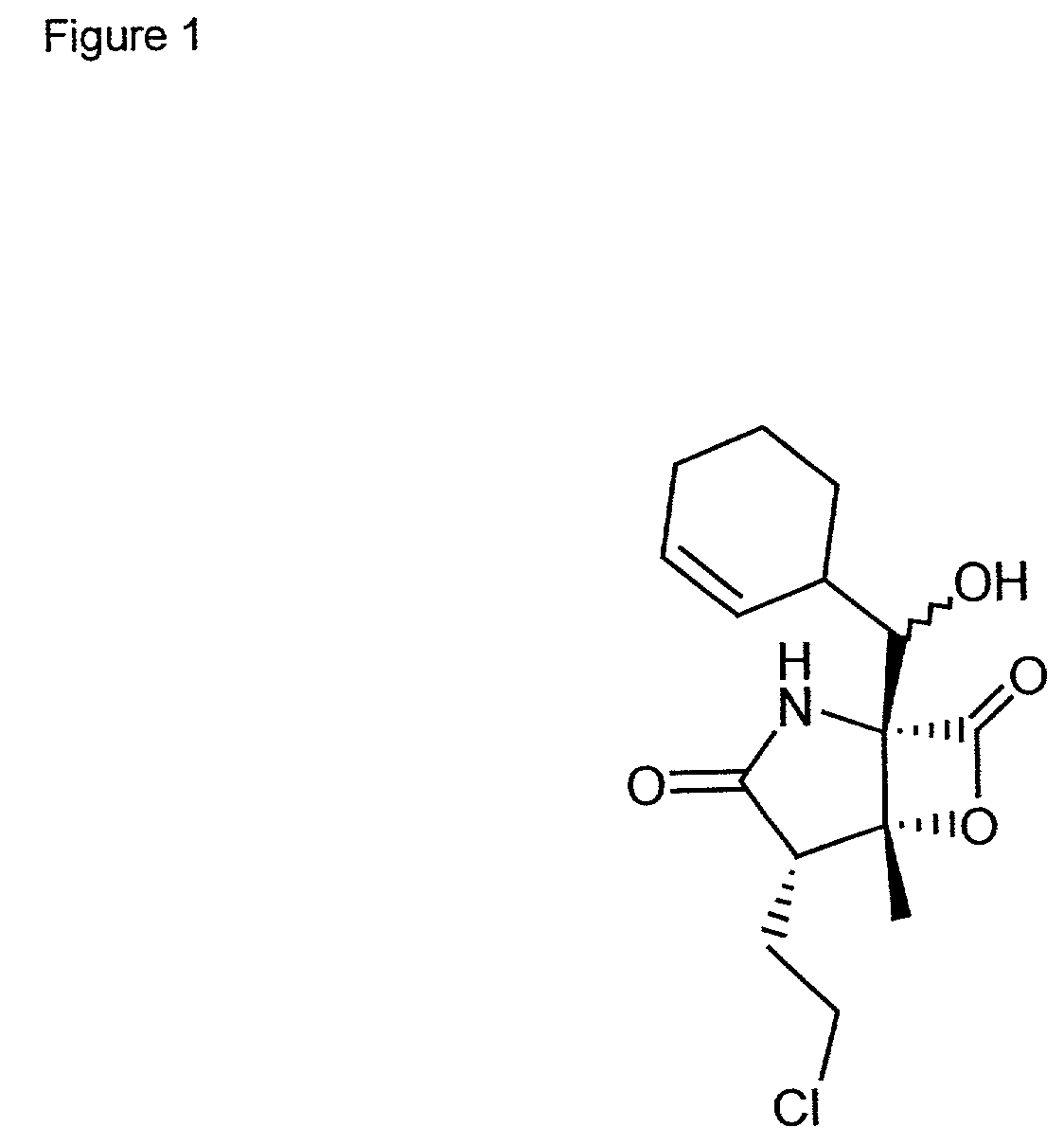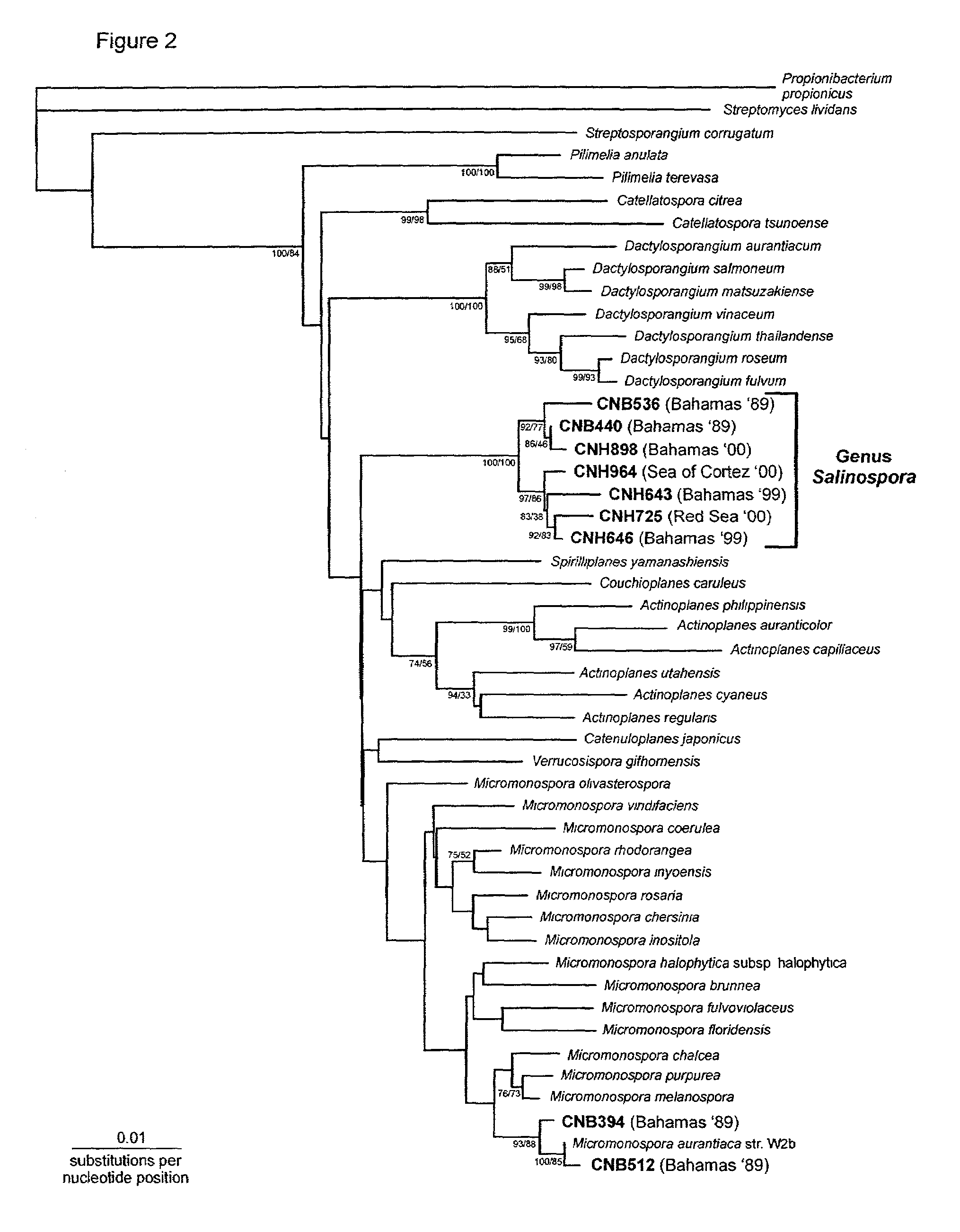Marine actinomycete taxon for drug and fermentation product discovery
a technology of marine actinomycete and drug discovery, applied in the field of marine actinomycete taxon for drug and fermentation product discovery, can solve the problems of low utility of marine actinomycete as source of novel industrial products, and low yield of novel products
- Summary
- Abstract
- Description
- Claims
- Application Information
AI Technical Summary
Benefits of technology
Problems solved by technology
Method used
Image
Examples
example 1
[0050]Sample collection and bacterial isolation. Samples of the top 1 cm of sediment were collected by SCUBA and processed by either stamping, dilution and heat-shock or both methods. Dilution and heat-shock was carried out as follows: 1 ml of wet sediment was added to 4 ml of sterile seawater, heated for six minutes at 55° C., shaken vigorously, and dilutions of 10−2 to 10−4 were inoculated onto agar media (M1–M4). For stamping, 10 ml of wet sediment were aseptically placed into a sterile aluminum dish, dried (ca. 24 hours) in a laminar flow hood, ground lightly with a pestle, pressed into a sterile foam plug (14 mm in diameter) and inoculated onto agar media (M1–M4) by stamping 8–9 times in a clockwise fashion giving a serial dilution effect. All isolation media were prepared with 100% filtered natural seawater. Actinomycetes generally appeared after 4–6 weeks of incubation at 25–28° C. and were considered as any colony with a tough leathery texture, dry or folded appearance and b...
example 2
[0052]DNA purification, amplification, sequencing and plylogenetic analyses. Genomic DNA was prepared as follows: 10 mg of vegetative mycelia grown on M1 agar for 2–4 weeks at 25–28° C. was macerated and an aqueous cleared lysate, created by standard methods, was precipitated with 0.7 volumes of isopropanol. The resultant DNA pellet was then washed with 70% ethanol and resuspended in 10 mM Tris buffer (pH 8.5) to a final concentration of 100 ng / ml. 16S rDNA sequencing templates were amplified from 10–50 ng of genomic DNA template by the PCR using the primers FC27 (5′ AGAGTTTGATCCTGGCTCAG) (SEQ ID 1) and RC1492 (5′ TACGGCTACCTTGTTACGACTT) (SEQ ID 2). PCR products were purified with a Qiagen QiAquick PCR clean-up kit using the manufacture's protocols. Partial sequences of morphologically diverse strains were obtained from nucleotides 80–480 (E. coli numbering system) using the FC27 primer. Select 16S rDNA amplicons were sequenced almost in their entirety on both top and bottom strands...
example 3
[0053]Genetic-analysis by Repetitive Extragenic Palindromic Polymerase Chain Reaction (REP-PCR). The genetic diversity of Salinospora strains was analyzed using REP-PCR (Versalovic et al., 1991). This technique, when applied to the Salinospora group, involves the use of total genomic DNA as a template and PCR primers specific for repetitive sequences present in the genomes of high G+C content Gram-positive bacteria. The length of the PCR products for any one strain will vary with the position of the repetitive sequences in the genome and result in a population of amplicons of various lengths that when separated on an agarose gel create strain-specific banding patterns. This high throughput method allows for the detection of genetically distinct strains and is more sensitive than 16S rRNA gene analyses as a method to assess genetic diversity. REP-PCR banding patterns are used to sort strains into distinct groups that can produce different gene products. Grouping of strains based on R...
PUM
| Property | Measurement | Unit |
|---|---|---|
| minimum inhibitory concentration | aaaaa | aaaaa |
| minimum inhibitory concentration | aaaaa | aaaaa |
| diameter | aaaaa | aaaaa |
Abstract
Description
Claims
Application Information
 Login to View More
Login to View More - R&D
- Intellectual Property
- Life Sciences
- Materials
- Tech Scout
- Unparalleled Data Quality
- Higher Quality Content
- 60% Fewer Hallucinations
Browse by: Latest US Patents, China's latest patents, Technical Efficacy Thesaurus, Application Domain, Technology Topic, Popular Technical Reports.
© 2025 PatSnap. All rights reserved.Legal|Privacy policy|Modern Slavery Act Transparency Statement|Sitemap|About US| Contact US: help@patsnap.com


